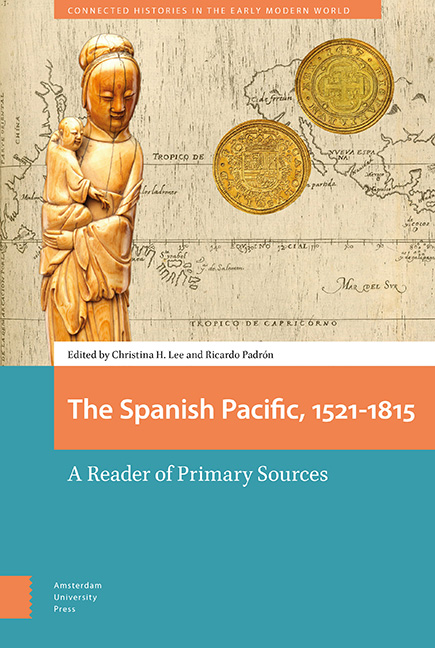Book contents
- Frontmatter
- Contents
- Abbreviations
- Acknowledgements
- Introduction
- 1 An Early Transpacific Account of the Spice Islands by Andrés de Urdaneta (1536)
- 2 Domingo de Salazar’s Letter to the King of Spain in Defense of the Indians and the Chinese of the Philippine Islands (1582)
- 3 Juan Cobo’s Map of the Pacific World (1593)
- 4 A Royal Decree of Philip III Regulating Trade between the Philippines and New Spain (1604)
- 5 Manila’s Sangleys and a Chinese Wedding (1625)
- 6 Don Luis Castilla Offers to Sell Land in Manila (1629)
- 7 Idolatry and Apostasy in the 1633 Jesuit Annual Letter
- 8 The Will of an Indian Oriental and her Chinos in Peru (1644
- 9 Francisco de Combés’s History of Mindanao and Jolo (1667)
- 10 Between Fiction and History in the Spanish Pacific The Misfortunes of Alonso Ramírez (1690)
- 11 A Moluccan Crypto-Muslim before the Transpacific Inquisition (1623–1645)
- 12 Constitutions and Rules of the Beatas Indias (1726)
- 13 The Poetics of Praise and the Demands of Confession in the Early Spanish Philippines: Notes and Documents
- 14 The Pacific Theater of the Seven Years’ War in a Latin Poem by an Indigenous Priest, Bartolomé Saguinsín (1766)
- 15 A Prohibition on Digging Up the Bones of the Dead (1813)
- Index
9 - Francisco de Combés’s History of Mindanao and Jolo (1667)
Published online by Cambridge University Press: 20 November 2020
- Frontmatter
- Contents
- Abbreviations
- Acknowledgements
- Introduction
- 1 An Early Transpacific Account of the Spice Islands by Andrés de Urdaneta (1536)
- 2 Domingo de Salazar’s Letter to the King of Spain in Defense of the Indians and the Chinese of the Philippine Islands (1582)
- 3 Juan Cobo’s Map of the Pacific World (1593)
- 4 A Royal Decree of Philip III Regulating Trade between the Philippines and New Spain (1604)
- 5 Manila’s Sangleys and a Chinese Wedding (1625)
- 6 Don Luis Castilla Offers to Sell Land in Manila (1629)
- 7 Idolatry and Apostasy in the 1633 Jesuit Annual Letter
- 8 The Will of an Indian Oriental and her Chinos in Peru (1644
- 9 Francisco de Combés’s History of Mindanao and Jolo (1667)
- 10 Between Fiction and History in the Spanish Pacific The Misfortunes of Alonso Ramírez (1690)
- 11 A Moluccan Crypto-Muslim before the Transpacific Inquisition (1623–1645)
- 12 Constitutions and Rules of the Beatas Indias (1726)
- 13 The Poetics of Praise and the Demands of Confession in the Early Spanish Philippines: Notes and Documents
- 14 The Pacific Theater of the Seven Years’ War in a Latin Poem by an Indigenous Priest, Bartolomé Saguinsín (1766)
- 15 A Prohibition on Digging Up the Bones of the Dead (1813)
- Index
Summary
Abstract
In this excerpt from his history of the southern Philippines and of the efforts of the Jesuits to convert its inhabitants, Francisco de Combés (1620–1665) paints a sensationalist image of the religious life of Mindanao, emphasizing the supposed atheism of the common people and the practice of sorcery by their Muslim rulers. The heroic Jesuits operating out of the Spanish settlement of Zamboanga struggle with the volatile politics of the Islamicate south in their heroic efforts to bring Christianity to people that they misrecognize as “moors.” Ana M. Rodríguez-Rodríguez places the text in the context of Spain's troubled relationship with Mindanao.
Keywords: Jesuits; Islam; Mindanao; missionary rhetoric; Zamboanga
The History of Mindanao and Jolo (Historia de Mindanao y Joló), written by the Jesuit Francisco de Combés and published in Madrid in 1667, is a long treatise comprised of eight books that study the geography of the southern Philippines and the ethnic, social, political, and religious characteristics of their inhabitants. It includes a presentation of the Spanish conquest in the area and the Spaniards’ relationships and conflicts with the natives, focusing mainly on the presence of Muslims in this part of the Spanish empire.
When the Spaniards arrived in the Philippines at the beginning of the sixteenth century, they were surprised by the presence of Muslim communities in the South of the archipelago. The arrival of the Spaniards to the southern islands of the Philippines gave way to a series of politicomilitary battles known as Moro Wars, which determined life in the islands for generations. Between 1599 and 1635, there were active rebellions against Spanish settlements. In 1635, the Zamboanga fort was established in the south of Mindanao. Threatened by a possible Dutch attack in Manila and exhausted by the ineffectiveness of their efforts, the Spaniards were forced to establish peace treaties with the Muslim rulers. These treaties, however, did not last long. Finally, the Spaniards left Zamboanga and the other forts in the area in 1663, afraid of a Chinese attack in Manila led by the corsair Koxinga (or Coseng in Spanish).
- Type
- Chapter
- Information
- Spanish Pacific, 1521–1815A Reader of Primary Sources, pp. 141 - 156Publisher: Amsterdam University PressPrint publication year: 2020
- 1
- Cited by

